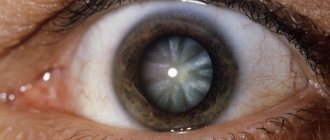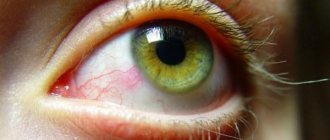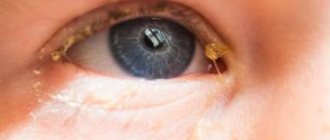The organs of vision are protected from problems such as eye infections by the anatomical barrier of the eyelid. Moreover, with the help of the blink reflex, continuous hydration occurs. The infectious process can affect any part of the eye, including the eyelids, conjunctiva, and cornea.
Infectious eye diseases most often manifest themselves in the form of symptoms characteristic of conjunctivitis - inflammation of the outer mucous membrane of the eye.
Ophthalmic diseases can occur for a number of reasons: tear film pathologies, trauma, weakened immune system. Inflammation is characterized by the appearance of unpleasant sensations, among which are decreased visual acuity, increased sensitivity to light, eye pain, redness, the appearance of discharge and crusts.
The effectiveness of treatment in children and adults directly depends on timely diagnosis, which should be carried out by a qualified specialist. What eye infections exist, what are they called, what signs are they characterized by, and is it possible to get rid of them? We'll talk about this and much more later in the article.
Causes of infectious eye diseases
Pathological conditions of the eyes are provoked by various microflora of a bacterial or viral nature. The following factors contribute to the spread of the pathogen:
- eye injuries;
- entry of foreign particles into the eyes;
- violation of hygiene standards;
- decrease in the immunological status of the body;
- allergic manifestations;
- prolonged fatigue of the visual apparatus;
- contact with an infected person;
- long-term therapy with immunosuppressive medications;
- dry air;
- failure to comply with the rules for wearing contact products.
The possibility of infection increases when chronic diseases are present in the body:
- sugar pathology;
- immunodeficiency;
- long-term therapy with hormonal medications;
- alcoholism.
The pathogen penetrates through airborne droplets or contact. Depending on the class of pathological microflora, the following forms of diseases are distinguished:
- viral;
- fungal;
- bacterial;
- conditionally pathological.
Prevention
The basic rule for preventing eye diseases is maintaining personal hygiene.
- Do not rub your eyes with your hands.
- Remove makeup from your face before going to bed.
- Be sure to shower and wash.
- Do not use other people’s hygiene products, even within the family.
- Properly care for contact lenses and adhere to the terms of wearing them.
- Use clean eye tissues or disposable paper napkins.
- Once a year, undergo a preventive examination with a therapist and ophthalmologist.
- Carry out wet cleaning indoors more often.
- Avoid swimming in public bodies of water and swimming pools.
- Completely cure any disease.
- Avoid the possibility of injury.
- Compliance with safety regulations.
- Do not wear lenses during a cold or ARVI, or replace them with daily ones.
- Protect your eyes when working with hazardous liquids and objects.
- Maintain immunity: take multivitamin complexes, follow a rest and sleep schedule, dress for the weather.
- Use only individual pipettes. Sterilize them.
- If possible, avoid direct contact with sick people.
Viral infections
When a viral pathogen enters the body, an inflammatory process with severe symptoms develops. Viruses that can cause eye pathologies include:
- adenoviruses;
- rubella;
- herpes;
- measles;
- chicken pox;
- mononucleosis;
- immunodeficiency.
With a weakened immunological reaction of the body, a viral eye disease may appear during ARVI. Infections of the visual apparatus are especially common:
Adenoviral infection of the visual apparatus
Microflora belongs to the acute respiratory group. Symptomatically, the lesion manifests itself as a cold:
- hyperthermia;
- swollen lymph nodes;
- presence of sore throat;
- sinusitis.
Conjunctivitis with adenovirus infection manifests itself through symptoms:
- hyperemia of the eyeball;
- photophobia;
- the appearance of swelling;
- itching sensation;
- transparent discharge appears.
Herpes eye infection
Symptoms of the lesion are similar to an allergic reaction. Symptomatically, the pathology manifests itself:
- intolerance to bright lighting;
- redness;
- decreased visual acuity;
- blurry picture;
- doubling of objects;
- pain syndrome;
- increased lacrimation.
Lack of therapy leads to complete blindness of the patient.
Do your eyes itch with coronavirus?
Itching is not a specific symptom of COVID-19. But despite this, in many patients it is present in the clinical picture. Eyes become red and itchy due to coronavirus in the event of direct or indirect (artificial) contact of the virus with the mucous membrane. Itching, swelling, redness can be the result of autoimmune processes, injuries, allergic reactions that occur in parallel with coronavirus.
But coronavirus doesn’t always hurt your eyes. Inflammation of blood vessels, severe itching, dryness, burning may indicate the presence of ophthalmological diseases:
- Viral, bacterial conjunctivitis not associated with COVID-19. A distinctive feature of the disease is copious secretion of yellowish mucus and sticking of the eyelids in the morning.
- Blepharitis. Inflammation of the eyelids, which is accompanied by a feeling of dryness, a foreign body, and profuse lacrimation. Blepharitis can also be recognized by severe redness of the eyelids.
- Barley. Acute purulent inflammation of the sebaceous gland or hair follicle of the eyelash is accompanied by redness, itching, pinpoint pain, and swelling of the eyelid.
- Dry eye syndrome (xerophthalmia). Prolonged redness of the white of the eye can occur due to impaired tear production. When the lacrimal glands produce little secretion, the cornea and conjunctiva dry out and become irritated. Most often, xerophthalmia develops with constant use of certain medications, hormonal changes in the body, systematic overwork of the visual organ, and prolonged work at the computer.
It is noteworthy that the listed conditions develop without fever and can affect only one eye. This behavior is not typical for coronavirus. The infection usually affects both eyes and is often accompanied by fever.
Bacterial infections
Bacterial pathogens affect the organs of vision upon contact with infected people. The proliferation of pathological microflora leads to pathologies:
Conjunctivitis
Conjunctivitis is provoked by pathological microflora of a viral or bacterial nature.
In case of a bacterial disease, it is necessary to begin therapy immediately, as complications may develop. Due to the active proliferation of bacterial microflora, perforation of the cornea is observed, which leads to complete blindness.
Barley
Barley is characterized by suppuration in the sebaceous gland area, which is provoked by streptococci or staphylococci. Symptoms of the disease are:
- pain syndrome;
- swelling;
- hyperemia of the eyelid.
The disease can affect one eye or two at the same time. Initially, a painful area forms on the eyelid, which in a few days will turn into an abscess.
Blepharitis
Inflammation spreads to the eyelash area on the eyelid. Among the symptoms of blepharitis, the most pronounced are:
- tearfulness;
- itching sensation;
- photophobia;
- eyelash loss;
- violation of proper growth.
Dacryocystitis
Inflammation of the tear duct is caused by staphylococci and streptococci. Due to swelling of the canal, stagnation of tear fluid is observed, which provokes inflammation. Symptoms observed with dacryocystitis:
- redness of the inner corner of the eye;
- pain syndrome;
- purulent discharge.
Abscess
The formation is characterized by severe pain and severe swelling. The development of an abscess is provoked by a pseudomonas pathogen or staphylococcus. An area of redness appears on the eyelid. Temporary hyperemia is possible.
Keratitis
Keratitis develops due to the progression of bacteria in the cornea. The disease is accompanied by general symptoms, as well as severe pain. A complication of the pathology is necrosis of the eyeball tissue and the development of an abscess.
Dacryoadenitis
Dacryoadenitis is a lesion of the lacrimal gland, which develops as a result of influenza, colds or sinusitis. When the disease occurs:
- swelling of the outer corner of the eye;
- severe pain;
- enlarged lymph nodes in the affected area;
- drooping eyelid;
- downward displacement of the eyeball.
Tuberculous keratitis
The cornea is affected due to the proliferation of the tuberculosis pathogen. One eye may be affected. With the active course of the disease, the formation of a cataract is observed.
Diphtheria conjunctivitis
The diphtheria bacillus provokes the development of a pathological condition. As a result of the disease, the following is observed:
- swelling;
- hyperemic mucosa;
- formation of gray plaque;
- discharge of cloudy secretion with flakes;
- gray coating.
Iridocyclitis
Iridocyclitis occurs due to an inflammatory reaction in the anterior part of the eye. There is a deterioration in the tolerance to bright lighting, the level of vision decreases, and increased secretion of tear secretion appears. An additional symptom of the disease is the appearance of plaque on the lens.
Do your eyes water when you have coronavirus?
COVID-19 antigens are foreign to the body. Therefore, when the virus enters the mucous membranes, inflammation immediately begins. It can be both intense and insignificant.
In some cases, the inflammatory process is accompanied by lacrimation. Firstly, in this way the body tries to reject the virus. Secondly, increased tear production may be associated with conjunctival irritation caused by an inflammatory response.
With coronavirus, dryness may appear, which is evidence of a disruption in the stability of the tear film. Therefore, in order to speed up the process of its restoration and prevent the cornea from drying out, the body activates the production of tear secretion. Lacrimation can also occur due to the penetration of pathogenic microflora into the lacrimal canal. In this case, antibiotics must be used to prevent serious complications.
Chlamydia infection
Single-celled microorganisms are activated when the body’s immunological reaction is reduced. Provoke the development of an infectious pathogen:
- pregnancy;
- emotional stress;
- hypothermia of the body.
Pathogenic microflora affects various parts of the visual organs:
- mucous membrane of the eyes;
- cornea;
- tissue structure located between the conjunctiva and sclera;
- meibomian glands;
- blood vessels.
The latent period of pathology lasts up to 2 weeks. In case of infection, the patient must be kept away from other family members and adhere to the rules of hygiene. Due to the active proliferation of pathogenic microflora, the development of complete blindness is possible.
Clinical manifestations
The large number of eye infections causes the possibility of various symptoms to appear. How exactly the disease will progress depends on the type of infection, the degree of its severity, as well as on the individual characteristics of the patient’s body.
Redness of the whites and watery eyes are the first signs of an eye infection.
The most common symptoms of eye infections are:
- Redness of the whites;
- Increased tear production;
- Various discomforts. As a rule, this is itching, tingling or pain;
- Swelling of nearby skin. Visually it is most pronounced on the upper eyelids;
- Discharge from the eyes. The color, depending on their nature and consistency, can be transparent, white, yellow or more green. The last two options may indicate the presence of bacteria;
- Crusts. It is because of their appearance that the eyelids often stick together, and the eye can be difficult, and sometimes even impossible to open without special procedures.
And even if we assume that the patient does not have the opportunity to immediately see a doctor, and he tries to relieve inflammation on his own for a couple of days, then there are symptoms for which it is strongly recommended not to waste time and visit a medical facility. These include:
- Severe swelling and redness;
- Continuous tearing;
- Sensation of a foreign object in the eye;
- Severe pain in the eyes;
- Photophobia. It is expressed in the pathological sensitivity of the pupils to bright light;
- Deterioration of vision. Blur appears. In some cases, even partial loss may be observed.
Eye diseases in children manifest themselves in a similar way.
Diagnostics
To determine pathogenic microflora, consultation with an ophthalmologist is necessary.
Additionally, diagnostic measures are carried out:
- study of anamnesis;
- examination of the fundus of the eyeball;
- checking the level of vision;
- corneal examination;
- microflora smear.
Based on the obtained biological material, a group of analyzes is carried out:
- molecular;
- histological;
- The sensitivity of microflora to medications is determined.
↑ Blepharitis
This disease is a focus of inflammation localized on the edge of the upper or lower eyelid (sometimes the inflammation affects the edges of both eyelids). The reasons for the development of blepharitis can be prolonged exposure to the eyes of caustic substances, volatile liquids, smoke (when working in hazardous industries), the presence of a chronic source of infection in the body, or infection after minor injury to the eyelids.
There are 3 forms of this disease
- simple, ulcerative and scaly.
- Simple blepharitis
is redness of the edges of the eyelids, which does not extend to the surrounding tissues and is accompanied by slight swelling. The patient experiences unpleasant sensations in the eyes (“a speck has gotten into it,” “an eyelash has curled up”). After rinsing with cool water, these symptoms do not disappear. The frequency of eyelid movements gradually increases (the patient begins to blink frequently), and foamy or purulent discharge may be observed from the inner corners of the eye. - Scaly blepharitis
is manifested by noticeable swelling and pronounced redness of the edges of the eyelids. A characteristic sign of this form of the disease is the formation on the eyelids (at the roots of the eyelashes) of grayish or pale yellow scales, similar to dandruff. When they are mechanically removed with a cotton swab, the skin becomes thinner and bleeds slightly. The patient feels severe itching in the eyelids; there may be complaints about the presence of a foreign body in the eye and pain when blinking. In advanced cases, the pain in the eyelids intensifies, which forces the patient to spend most of the daylight hours in a darkened room. Visual acuity may decrease. - Ulcerative blepharitis
is the most severe form of this disease. It begins with classic symptoms, which are described in detail above. Then the patient's condition noticeably worsens. A characteristic sign of ulcerative blepharitis is the presence of dried pus at the roots of the eyelashes. The resulting crusts cause eyelashes to stick together. It is very difficult to remove them, since touching the inflamed skin is quite painful. After the purulent crusts are eliminated, small ulcers remain on the eyelids. If treatment is not started in a timely manner, they heal very slowly, and eyelash growth is only partially restored. Later, unpleasant complications may occur - disturbances in the direction of eyelash growth, their loss, as well as other eye diseases (for example, conjunctivitis) caused by the further spread of infection.
Useful video
Depending on the symptomatic manifestations, a diagnosis of eye pathologies can be made. However, self-medication leads to the development of disease complications. At the first signs of diseases of the visual apparatus, it is necessary to consult an ophthalmologist and carry out diagnostics.
Author's rating
Author of the article
Alexandrova O.M.
Articles written
2029
about the author
Was the article helpful?
Rate the material on a five-point scale!
( 2 ratings, average: 3.00 out of 5)
If you have any questions or want to share your opinion or experience, write a comment below.
Causes
Eye infections most often occur due to the patient’s oversight or due to his neglect of simple hygiene standards. Eye diseases can occur for the following reasons:
- if you have a bad habit of rubbing or touching your eyes with dirty hands;
- when using someone else's personal hygiene products - towels, scarves, cosmetics and products or cosmetics;
- in direct contact with secretions of an infected person;
- if hygiene rules are violated at a makeup artist-stylist, in a beauty salon or in a medical facility;
- infection sometimes occurs after surgery on the organs of vision;
- as a complication of an infection in the body, for example, when a person is infected with the herpes virus;
- if the rules of hygiene, care and wearing of contact lenses are not followed;
- when neglecting to thoroughly cleanse the eyes of makeup, and also when a woman goes to bed with it on.
The overwhelming number of infectious diseases of the organs of vision can be avoided if you follow simple hygiene rules and listen to medical recommendations, as well as treat processes that manifest themselves in a timely manner, otherwise the consequences can be disastrous - the pathology will become chronic.
Herpes virus
Another common virus that causes conjunctivitis of the eyes is the herpes simplex virus. It occurs predominantly in children and has three clinical forms: catarrhal, follicular and vesicular ulcerative. Catarrhal conjunctivitis is characterized by mucous or purulent discharge, redness and swelling of the conjunctiva. With the follicular form, in addition to redness and swelling of the eyes (these signs are characteristic of almost all forms of the disease), bubbles with liquid content, called follicles, appear on the conjunctiva and eyelids. The vesicular-ulcerative type of the disease occurs with the formation of erosions or ulcers covered with films, often accompanied by the formation of dense nodules.
According to the course of the disease, herpetic conjunctivitis is also divided into three stages:
- acute herpetic - symptoms arise abruptly, while being pronounced;
- subacute herpetic - symptoms appear moderately;
- chronic herpetic - the signs of herpes are mild, but do not go away completely - the condition either improves or worsens; this form is difficult to treat.
Among the causes of herpetic conjunctivitis, doctors name a weakened immune system, hypothermia, excessive exposure to ultraviolet radiation, poor nutrition, and previous infections. All this weakens the body, into which viruses easily penetrate and begin to actively multiply. Herpes is transmitted by airborne droplets and household contact.
↑ Keratoconjunctivitis
This disease, caused by an adenovirus, usually develops against the background of simultaneous damage to the conjunctiva and cornea.
Keratoconjunctivitis is characterized by rapid spread. It is transmitted by contact and through personal belongings.
It takes about 7-8 days from the moment of infection before the first signs of the disease appear. First, a headache occurs, which is accompanied by chills, appetite disappears, and the patient complains of weakness and apathy. After some time, pain appears in the eyeballs, characteristic redness of the sclera is observed, and complaints about the presence of a foreign body in the eye are noted. Then very profuse lacrimation occurs, accompanied by the release of mucus from the lacrimal canal.
The upper and lower eyelids swell, the conjunctiva turns red, and very small blisters filled with clear liquid appear on it. The last symptom is a characteristic manifestation of adenovirus infection.
If treatment was not started on time, after 5-7 days the above signs of the disease gradually disappear, leaving only steadily increasing photophobia. Cloudy foci appear in the cornea - small, slightly transparent spots. Provided that appropriate therapy is carried out, complete healing occurs after 2-2.5 months.











